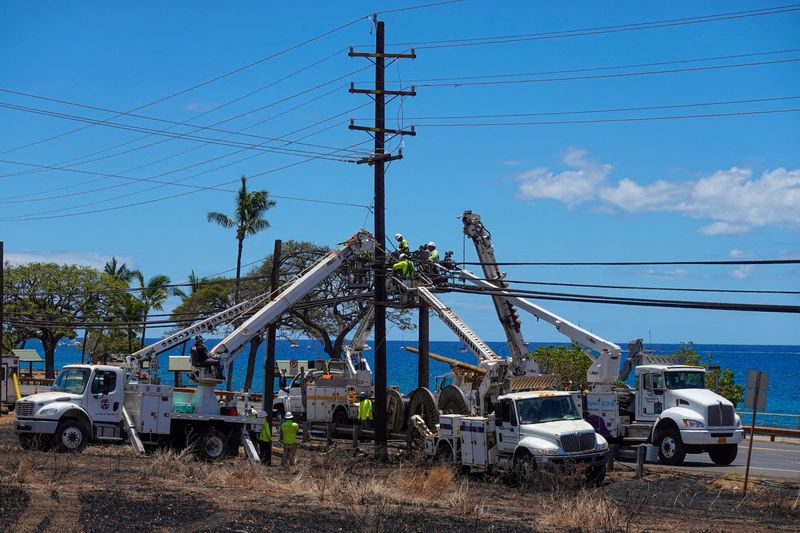Investing.com’s stocks of the week
By Tim McLaughlin and Tom Hals
(Reuters) - Hawaiian Electric’s CEO received an annual bonus last year tied to profit, worker safety and bolstering the supply of renewable energy, but not linked specifically to reducing wildfire risk, according to a Reuters review of company disclosures.
The state’s largest utility is being investigated over its role in the blaze that killed more than 114 people on the island of Maui earlier this month, the deadliest U.S. wildfire in a century. The county of Maui on Thursday sued Hawaiian Electric, accusing it of acting negligently by failing to shut down electric equipment, which the county said started the fire. Now, some investors, regulators and power industry analysts say pay incentives should be tied to cutting risk, a strategy that could help prevent catastrophic wildfire losses nationwide.
California utilities, which have also been blamed for deadly wildfires, have done so, but they are alone. “It’s a principle of human nature that people and businesses follow their incentives, so if we tie executive pay at many levels of the organization, not just the CEO, to safety and wildfire safety, then the organization will work harder to meet those goals,” said consultant Alison Silverstein, a former adviser to the U.S. Federal Energy Regulatory Commission. No cause has been identified. A class-action lawsuit blames the Honolulu-based utility company, alleging it failed to shut off power lines despite warnings that high winds might blow them down and spark wildfires. The utility declined to comment for this story. Hawaiian Electric CEO Shelee Kimura received a cash bonus in 2022 based on her performance against 10 measures including profit and customer satisfaction. Wildfire risk mitigation was not on the list, according to the utility’s pay disclosures. Kimura received 74%, or $337,500, of her potential bonus award that year – her first as CEO - because she missed seven out of 10 target goals, according to the disclosures. Wildfire risk had been a concern for several years before the blaze ripped through Lahaina, a historic resort town in Maui.
The Hawaii Wildfire Management Organization identified Lahaina as a hotspot with recurring fire starts in 2018. "Dry! Windy! Hot!", the report exclaimed in a description of Lahaina and nearby areas. U.S. electric utilities in other tinderbox states, including Idaho, Oregon and Washington, have also not tied compensation to the performance of utility executives charged with developing wildfire mitigation plans, according to a Reuters examination of their company pay disclosures.
California is the exception. Deadly conflagrations there in recent years – including the Camp Fire blaze that killed 86 people in 2018 - have forced investor-owned electric utilities to link wildfire mitigation efforts to executive pay. San Diego Gas & Electric, a unit of Sempra, pegged 20% of target bonus payouts for 2023 to wildfire mitigation and 33% to other safety measures, according to a plan that received preliminary state approval this month.
Hard-hit PG&E (NYSE:PCG) has spent $39 billion over the past five years on improvements that include wildfire mitigation; linked its CEO pay to fire preparation; and has seen its share price soar nearly 40% in the past year from a low suffered in wake of utility-caused fires in California.
“It’s tragic the lessons learned in California have not been applied everywhere else,” said Michael Cerasoli, portfolio manager of the TrueShares Eagle Global Renewable Energy Income Fund.
That California model, though relatively untested, should be more broadly adopted at utilities as climate change intensifies droughts and the frequency of severe windstorms in parts of the country, according to eight experts and utility investors interviewed by Reuters.
“Hawaiian Electric focused on different issues other than fire safety and has lost almost $3 billion in market capitalization” since the Maui fire, said Michael Underhill, chief investment officer at Capital Innovations. “If you want certain behavior from utility management you need to incentivize those behaviors and get regulators to buy-in to allow a reasonable return on those investments, which is also good corporate governance,” he said. TURN IT OFF
To be sure, some CEOs without direct pay incentives for wildfire management say they are working hard to prevent blazes.
In Idaho, another state buffeted by severe wildfires this year after an intense drought, the largest electric utility also does not explicitly link executive pay to cutting wildfire risk, according to its latest pay disclosure with the SEC. But Idacorp Chief Financial Officer Brian Buckham recently described wildfire mitigation efforts as substantial: caution is the rule during the dry season, when even the undercarriage of a utility truck can ignite crackly sage brush. “If the conditions are what we would call risky, we won't even drive in there with our trucks,” Buckham said at an Aug. 16 investment conference. Idacorp declined to comment on its pay practices and how they relate to wildfire mitigation.
Oregon’s big utility Portland General Electric (NYSE:GE) Co did not return messages seeking comment for this story.
Both states have significant fires now, according to authorities. Larry Glazer, a co-founder of Boston’s Mayflower Advisors, whose $4 billion in managed assets include utility holdings, said U.S. electricity systems suffer from decades of massive under investment. The issue is much bigger than Hawaiian Electric, he said. “You don’t want a wildfire disaster to be the catalyst for a change in public policy,” said Glazer, who supports linking executive pay to wildfire mitigation. “But that’s where we are.”
